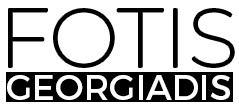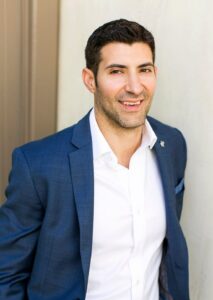Meet The Disruptors: Francesco Fazio Of Treacy & Company On The Five Things You Need to Shake Up Your Industry
An Interview with Fotis Georgiadis
Be human! Show up as yourself. In this world of digital everywhere, connect with people — your employees, your clients, your partners. My teams love a rule we have started — no PowerPoint slides on Monday morning client meetings. Instead, show up with a story about what you did this weekend and, if possible, of course, connect it with how relevant it is for the client’s situation. Monday meetings have become something the whole team looks forward to.
As a part of our series about business leaders who are shaking things up in their industry, I had the pleasure of interviewing Francesco Fazio.
Francesco is a Partner in Treacy & Company’s Chicago office and head of the innovation practice. He has 20+ years of experience helping clients launch new ventures, with discipline in business, service, and experience design. Francesco helps clients develop innovations that improve customer value, accelerate profitable growth, and establish market leadership with an approach that combines superior foresight, systems-level design thinking, agile concept development, and risk mitigation.
Thank you so much for doing this with us! Before we dig in, our readers would like to get to know you a bit more. Can you tell us a bit about your “backstory”? What led you to this particular career path?
I was born in Italy, a country of beautiful design in art, architecture, furniture, clothes, food, boats, cars. That’s where I cultivated the desire to design something really meaningful and beautiful in the world. This inspired me to go to design school in Italy and, later, to business school in the US. The intersection of design and business is where it came together for me. I realized that I love to design new businesses, offerings, and experiences to help companies delight their customers — and win in the market.
Can you tell our readers what it is about the work you’re doing that’s disruptive?
I help companies launch new viable business offerings, services, and experiences. That, very often, requires the courage to disrupt yourself before someone else does it to you. For example, I am helping a cat litter brand think through a litter box product system with a new innovative business model; a boat manufacturer design a unique boat sharing club to improve access to the category and the community around it; and an insurance company launch a new host of home wellness services. These things are always provocative and often disruptive to the core businesses of the companies that are exploring them. My role is to bring discipline and an innovative approach to my clients to navigate the uncertainty and de-risk these endeavors.
Can you share a story about the funniest mistake you made when you were first starting? Can you tell us what lesson you learned from that?
I was working for a company that provides agricultural solutions to farmers. This company has a rich database of what farmers buy from them, including products and services. Our job was to uncover some great patterns and insights from the data and provide my client with a solution to increase sales. The problem was that the pool of data was so large and diverse that it pointed us in the wrong direction. Our initial findings went something like this:
John runs a 100 acres farm that looks similar to Larry’s, but Larry buys less than half our product and no services. So, to get Larry to buy more services, wouldn’t it be nice to put him in the same room as John, maybe in some fancy hotel conference room? This way, Larry can learn from John why he buys the services he does, and of course, he’ll start buying them too. Maybe this singular event turns into an “alike customer” quarterly off-site event with great food, all sorts of networking events, a day of learning with presentations from our leaders. What a great idea — we will see double-digit growth right with the event while getting our customers to sell for us!
But wait, shouldn’t we check with these farmers if they would be interested?
I went to visit a dozen of them when I sat down and simply asked, “What excites you about farming.” The feedback I received was:
- Farmers like to be alone,
- They like to be out in the field, and
- No field is like any other. A big fancy event to get farmers to copy one another simply wouldn’t work. The biggest lesson is never to assume you know your customers better than they know themselves. That is at the core of what I practice now, Human-Centered Design.
We all need a little help along the journey. Who have been some of your mentors? Can you share a story about how they made an impact?
My first mentor was Paolo Caliari, a yacht designer and a direct descendant of the famous painter Paolo Veronese. That was my first job out of design school in Italy. I always appreciated Paolo’s ability to sit at a business lunch with a potential buyer, ask about what the buyer wanted, and then produce some beautiful ‘back of the napkin’ sketches for some boat designs (literally the back of the restaurant napkins). Paolo would always create three alternative designs and lay them out in front of the buyer and their spouse. There were a lot of learnings wrapped into those earlier business meetings: 1) always try to understand your customer; 2) when you learn something about them, do something about it at the moment, and 3) keep it simple — do as much of the thinking for them as possible. I apply these three simple rules in every client discussion, though I am admittedly still miles away from producing concept sketches on a napkin as beautifully as Paolo did.
In today’s parlance, being disruptive is usually a positive adjective. But is disrupting always good? When do we say the converse, that a system or structure has ‘withstood the test of time’? Can you articulate to our readers when disrupting an industry is positive, and when disrupting an industry is ‘not so positive’? Can you share some examples of what you mean?
I have a relatively simple and (perhaps) one-sided opinion here: disruption is always coming. In one way or another, whether you can see it or not, and whether you like it or not. It is never good to you when it comes unless you saw it coming and started to prepare for it. In other words, you might not want to trigger it (after all, no successful business wants to change things!). However, you absolutely must not act as if it won’t happen to you — as that’s death.
We all know the usual disruptions that created good things for the world but destroyed incumbents who didn’t embrace them. For example, Kodak not investing in digital cameras in an attempt not to disrupt their own core film business; Blockbusters not investing in streaming as “the people that go to our stores like to meet their neighbors, and the physical touch of a DVD box.” But what about the people that don’t go to your stores? Hello, Netflix.
Interestingly, to anticipate and embrace disruption and turn it into new value-creating innovation, you must think beyond your customers. As the famous adage by Henry Ford goes, “if I had asked my customers what they wanted, they would have answered a faster horse.”
Can you share 3 of the best words of advice you’ve gotten along your journey? Please give a story or example for each.
1) Know your strengths before you know your weaknesses.
A fond memory from my days in business school was my role in the admission office conducting interviews of prospective students. The standard question was, “What is more important, to know your strengths or your weaknesses.” The even more standard answer always came as: “the weaknesses, so you can work to improve them over time.” Until this one applicant said, “your strengths! Because under pressure, you will always default on the weaknesses, and it is best to go where your strengths are.” I will never forget that advice. In my case, I know my strength is in infusing enthusiasm and energy into my work and seeing the glass as always half full. Staying true to myself and playing on my strengths has helped me in many situations where I needed it!
2. Define your personal brand. If you don’t do it, people will define it for you.
This connects very tightly with the point above. Be very clear about who you are and what you want to be known for (and ideally build that on what objective strengths you bring to the table). In one situation where I wanted to emphasize my “challenger” mindset, I made a point in the client meetings to only ask disconfirming questions.
3. Be human! Show up as yourself.
In this world of digital everywhere, connect with people — your employees, your clients, your partners. My teams love a rule we have started — no PowerPoint slides on Monday morning client meetings. Instead, show up with a story about what you did this weekend and, if possible, of course, connect it with how relevant it is for the client’s situation. Monday meetings have become something the whole team looks forward to.
As a disruptor, how are you going to shake things up next?
I will continue to be curious, empathetic, and daring. I will also continue spending as much time with my adorable three little girls — ages nine, eight, and six. They don’t have boundaries of what is accepted/acceptable as much as we adults do. By observing how fast they are growing, evolving their thinking, and approaching the world, I am learning more than I could hope to be innovative!
This was very inspiring. Thank you so much for joining us!
Meet The Disruptors: Francesco Fazio Of Treacy & Company On The Five Things You Need to Shake Up… was originally published in Authority Magazine on Medium, where people are continuing the conversation by highlighting and responding to this story.



